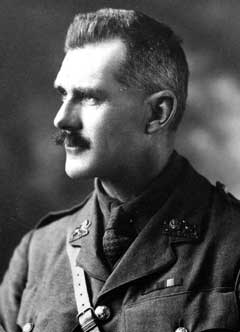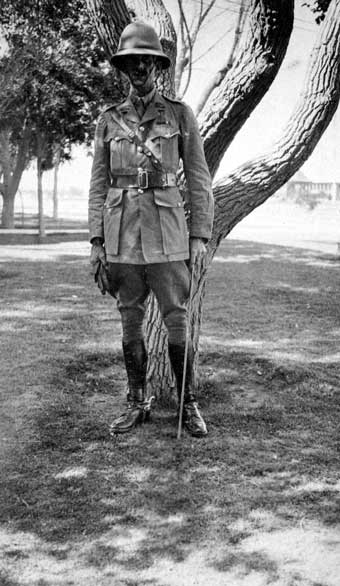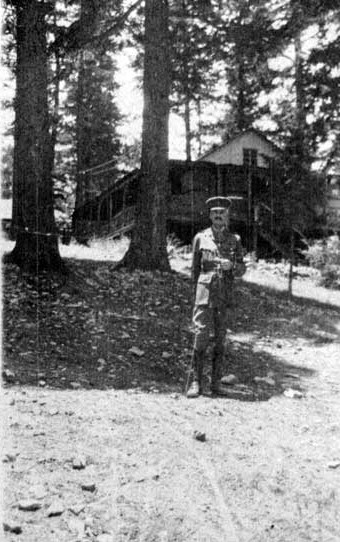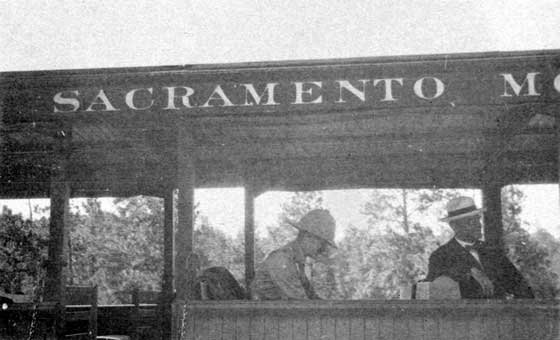Soldiers of the RegimentMajor Henry
Dearden Matson
Account of the 1st July 1916 and the first day of
the Battle of the Somme by Major Henry Dearden Matson, 1st King's Own.

Major Henry Dearden Matson.
Accession Number: KO1307/07
Transcript of a letter from the Somme battlefield by Major Henry
Dearden Matson, 1st Battalion, The King’s Own Royal Lancaster Regiment,
to his sister, Arzilles Matson, in Douglas, Isle of Man.
10th July 1916
Dearest Arziles,
We are now out for a rest after 9 days of strenuousness, to reorganise
after our somewhat severe losses. The Battalion is full of kick and
ready to go until it drops, but the powers that be seem to think we have
done enough for the present. I can’t even yet realize so many have gone
from us, but coming back to the same mess room we occupied before the
battle brings it home to one. No use to dwell on that however. They die
that England may live. The Battalion advanced – ‘went over the top’ at
7.30 am on Saturday 1st July. It was the left leading Battalion of the
Brigade and the men marched out into a withering fire of machine guns
and shells as if they were on manoeuvres. Whole sections were swept away
but nothing stopped them. They surged up over the German front trenches
in their proper formations until they reached a point from which it was
impossible to proceed any further. A village which should have been
taken by a division on the left was not taken. A hill and another
village on the right resisted the efforts of another division to take
it, so the poor old Bn. was left out alone in the front unsupported on
either flank rapidly crumbling away under the concentrated crossfire of
the Bosches were able to bring on it. Orders had to be sent up to retire
and by nightfall it was back again in its assembly trenches and its
glorious charge had achieved no result. Three officers were left of
those who went over but others have come up and we are reorganising. For
the first few days, I was in command as poor Bromilow
is missing, the
whole of Headquarters except me wiped out. We had to work our hardest in
the worst conditions clearing the battlefield & preparing for another
attack, being heavily shelled all the time. I have many mentions to make
& at least two of my officers should get DSOs. The conditions were most
difficult, but I managed to get a supply of hot soup for the men, who
could cook nothing – too wet – greatcoats – they were in fighting order
– change of socks, and did a lot of talking & cheering of them up. We
could get no sleep that was the worst – work had to be done & we had to
do it, and hold the enemy as well.
The 4th Division has done its work which was to draw the strongest
possible German force to its front so that the French could smash
through on the right, and they have done it, so that our Battalion
according to all the Generals who had been interviewing us lately has
covered itself with glory, even if it is reduced to half its strength. I
feel poor Young’s death too much. I love the merry young fellow; only 19
& a company commander and veteran too. Then there’s Weatherhead, and
Rowley and Hablutzel and Clegg, MacWalk’s, the fearless, Melly, with the
bull’s roar in a fight, all killed and fourteen others wounded or
missing; nearly all our gallant crew of officers. When a man is posted
as missing it means that nobody present could say whether he was killed
or wounded – there was no information. He may be killed, or wounded, or
a prisoner. So now we are having this much needed rest. It is only a
rest from the shelling and fighting, as there is hard work to be done
straightening out companies and bringing them up to strength replacing
specialists, signallers, Lewis gunners and so forth. We can do it in a
week and be ready to fight again as we have fought before. Three times
in this war this Battalion has been practically wiped out but it has
always got going again. The discipline was magnificent, no regiment
could have behaved better and all through the bitter days following not
a murmur from the men. They are wonderful. Nothing daunts them and they
are ready as they were this time to achieve the impossible.
Much love to you both from
Harry.

Major Henry Dearden Matson, King’s Own Royal Lancaster Regiment and
Machine Gun Corps. Photographed at Fort Bliss, Texas, United States of
America, where he was posted in 1918
Fort Bliss, in New Mexico and Texas, with headquarters today located in
El Paso, was named in honour of Lieutenant Colonel William Bliss
(1815-1853)
Accession Number: KO3100/74

Unidentified British Officer at Fort Bliss, Texas, United State of
America, Jun 1918
Accession Number: KO3100/75

Unidentified British Officer at Fort Bliss, Texas, United State of
America, Jun 1918
Accession Number: KO3100/76

Possibly Major Henry Dearden Matson, King’s Own, on board a tram or bus,
marked ‘Sacramento’. United States of America, 1918.
Accession Number: KO3100/77

Visiting Card for Major Henry Dearden Matson, King’s Own Royal Lancaster
Regiment and Machine Gun Corps. With the address of Junior Army and Navy
Club printed on the card, and “Q?? No. 20 Fort Bliss, Texas” written at
the top, assumed to be his quarters in the camp.
Accession Number: KO3100/78
© Images are copyright, Trustees of the King's Own Royal Regiment Museum.
You must seek permission prior to
publication of any of our images.
Only a proportion of our collections
are on display at anyone time. Certain items are on loan for display
in other institutions. An appointment is required to consult any of
our collections which are held in store.







